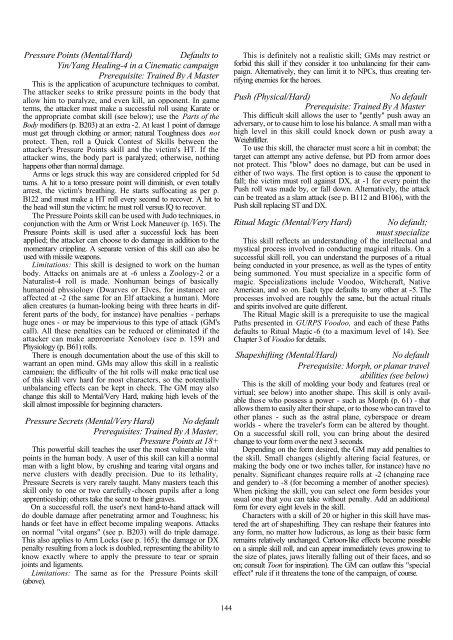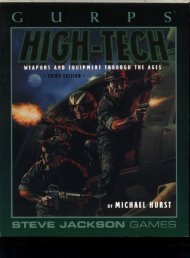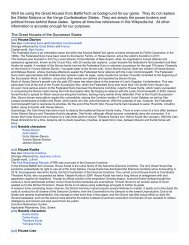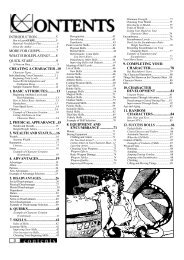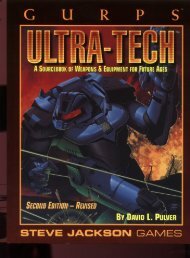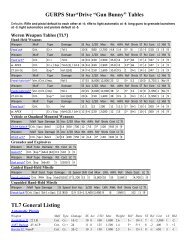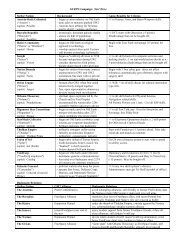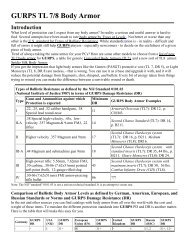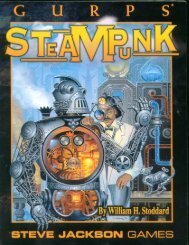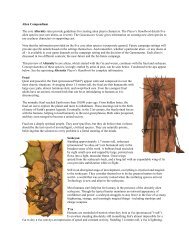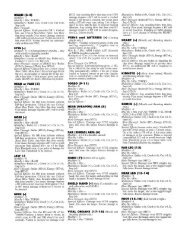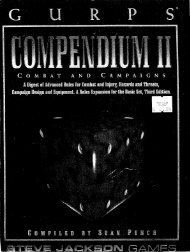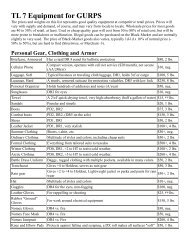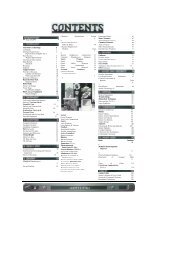GURPS - Compendium 1..
GURPS - Compendium 1..
GURPS - Compendium 1..
Create successful ePaper yourself
Turn your PDF publications into a flip-book with our unique Google optimized e-Paper software.
Pressure Points (Mental/Hard)<br />
Defaults to<br />
Yin/Yang Healing-4 in a Cinematic campaign<br />
Prerequisite: Trained By A Master<br />
This is the application of acupuncture techniques to combat.<br />
The attacker seeks to strike pressure points in the body that<br />
allow him to paralyze, and even kill, an opponent. In game<br />
terms, the attacker must make a successful roll using Karate or<br />
the appropriate combat skill (see below); use the Parts of the<br />
Body modifiers (p. B203) at an extra -2. At least 1 point of damage<br />
must get through clothing or armor; natural Toughness does not<br />
protect. Then, roll a Quick Contest of Skills between the<br />
attacker's Pressure Points skill and the victim's HT. If the<br />
attacker wins, the body part is paralyzed; otherwise, nothing<br />
happens other than normal damage.<br />
Arms or legs struck this way are considered crippled for 5d<br />
turns. A hit to a torso pressure point will diminish, or even totally<br />
arrest, the victim's breathing. He starts suffocating as per p.<br />
B122 and must make a HT roll every second to recover. A hit to<br />
the head will stun the victim; he must roll versus IQ to recover.<br />
The Pressure Points skill can be used with Judo techniques, in<br />
conjunction with the Arm or Wrist Lock Maneuver (p. 165). The<br />
Pressure Points skill is used after a successful lock has been<br />
applied; the attacker can choose to do damage in addition to the<br />
momentary crippling. A separate version of this skill can also be<br />
used with missile weapons.<br />
Limitations: This skill is designed to work on the human<br />
body. Attacks on animals are at -6 unless a Zoology-2 or a<br />
Naturalist-4 roll is made. Nonhuman beings of basically<br />
humanoid physiology (Dwarves or Elves, for instance) are<br />
affected at -2 (the same for an Elf attacking a human). More<br />
alien creatures (a human-looking being with three hearts in different<br />
parts of the body, for instance) have penalties - perhaps<br />
huge ones - or may be impervious to this type of attack (GM's<br />
call). All these penalties can be reduced or eliminated if the<br />
attacker can make appropriate Xenology (see p. 159) and<br />
Physiology (p. B61) rolls.<br />
There is enough documentation about the use of this skill to<br />
warrant an open mind. GMs may allow this skill in a realistic<br />
campaign; the difficulty of the hit rolls will make prac tical use<br />
of this skill very hard for most characters, so the potentially<br />
unbalancing effects can be kept in check. The GM may also<br />
change this skill to Mental/Very Hard, making high levels of the<br />
skill almost impossible for beginning characters.<br />
Pressure Secrets (Mental/Very Hard) No default<br />
Prerequisites: Trained By A Master,<br />
Pressure Points at 18+<br />
This powerful skill teaches the user the most vulnerable vital<br />
points in the human body. A user of this skill can kill a normal<br />
man with a light blow, by crushing and tearing vital organs and<br />
nerve clusters with deadly precision. Due to its lethality,<br />
Pressure Secrets is very rarely taught. Many masters teach this<br />
skill only to one or two carefully-chosen pupils after a long<br />
apprenticeship; others take the secret to their graves.<br />
On a successful roll, the user's next hand-to-hand attack will<br />
do double damage after penetrating armor and Toughness; his<br />
hands or feet have in effect become impaling weapons. Attacks<br />
on normal "vital organs" (see p. B203) will do triple damage.<br />
This also applies to Arm Locks (see p. 165); the damage or DX<br />
penalty resulting from a lock is doubled, representing the ability to<br />
know exactly where to apply the pressure to tear or sprain<br />
joints and ligaments.<br />
Limitations: The same as for the Pressure Points skill<br />
(above).<br />
This is definitely not a realistic skill; GMs may restrict or<br />
forbid this skill if they consider it too unbalancing for their campaign.<br />
Alternatively, they can limit it to NPCs, thus creating terrifying<br />
enemies for the heroes.<br />
Push (Physical/Hard)<br />
No default<br />
Prerequisite: Trained By A Master<br />
This difficult skill allows the user to "gently" push away an<br />
adversary, or to cause him to lose his balance. A small man with a<br />
high level in this skill could knock down or push away a<br />
Weightlifter.<br />
To use this skill, the character must score a hit in combat; the<br />
target can attempt any active defense, but PD from armor does<br />
not protect. This "blow" does no damage, but can be used in<br />
either of two ways. The first option is to cause the opponent to<br />
fall; the victim must roll against DX, at -1 for every point the<br />
Push roll was made by, or fall down. Alternatively, the attack<br />
can be treated as a slam attack (see p. B112 and B106), with the<br />
Push skill replacing ST and DX.<br />
Ritual Magic (Mental/Very Hard) No default;<br />
must specialize<br />
This skill reflects an understanding of the intellectual and<br />
mystical process involved in conducting magical rituals. On a<br />
successful skill roll, you can understand the purposes of a ritual<br />
being conducted in your presence, as well as the types of entity<br />
being summoned. You must specialize in a specific form of<br />
magic. Specializations include Voodoo, Witchcraft, Native<br />
American, and so on. Each type defaults to any other at -5. The<br />
processes involved are roughly the same, but the actual rituals<br />
and spirits involved are quite different.<br />
The Ritual Magic skill is a prerequisite to use the magical<br />
Paths presented in <strong>GURPS</strong> Voodoo, and each of these Paths<br />
defaults to Ritual Magic -6 (to a maximum level of 14). See<br />
Chapter 3 of Voodoo for details.<br />
Shapeshifting (Mental/Hard)<br />
No default<br />
Prerequisite: Morph, or planar travel<br />
abilities (see below)<br />
This is the skill of molding your body and features (real or<br />
virtual; see below) into another shape. This skill is only available<br />
thos e who possess a power - such as Morph (p. 61) - that<br />
allows them to easily alter their shape, or to those who can travel to<br />
other planes - such as the astral plane, cyberspace or dream<br />
worlds - where the traveler's form can be altered by thought.<br />
On a successful skill roll, you can bring about the desired<br />
change to your form over the next 3 seconds.<br />
Depending on the form desired, the GM may add penalties to<br />
the skill. Small changes (slightly altering facial features, or<br />
making the body one or two inches taller, for instance) have no<br />
penalty. Significant changes require rolls at -2 (changing race<br />
and gender) to -8 (for becoming a member of another species).<br />
When picking the skill, you can select one form besides your<br />
usual one that you can take without penalty. Add an additional<br />
form for every eight levels in the skill.<br />
Characters with a skill of 20 or higher in this skill have mastered<br />
the art of shapeshifting. They can reshape their features into<br />
any form, no matter how ludicrous, as long as their basic form<br />
remains relatively unchanged. Cartoon-like effects become possible<br />
on a simple skill roll, and can appear immediately (eyes growing to<br />
the size of plates, jaws literally falling out of their faces, and so<br />
on; consult Toon for inspiration). The GM can outlaw this "special<br />
effect" rule if it threatens the tone of the campaign, of course.<br />
144


